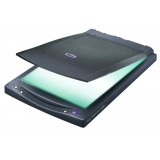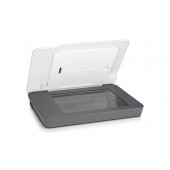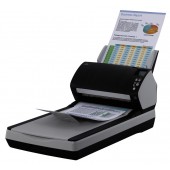Shopping Cart
0 item(s) - AED 0.00Scanners

Practically all scanners today are single-pass types with 48-bit color. Gone are the scanners of yore that required three passes to capture the full RGB (red, green, blue) color information from an image in individual, painstakingly slow takes. Gone too are 24-bit and 36-bit scanners that proved sufficient in the past for delivering up to 68.7 billions of color.
Today's single-pass, 48-bit scanners are fast and can theoretically capture up to 250 trillion colors -- clearly more color than the human eye can distinguish or what monitors and printers can reproduce -- but impressive nonetheless for the promise of yielding hues as close to life as possible and delivering smoother color gradations. Ignore all but single-pass scanners when shopping for a flatbed, and aim for 48-bit color as well. Consider lower-bit models (such as 42-bits) only if your scanner of choice has other specs that a higher-bit counterpart may not have -- such as patented technologies and special features -- that more than compensate for the lower bit depth of your selected model.
Resolution
The resolution of a scanner determines the level of detail that can be captured; the higher the resolution, the sharper the scan will be. There are two types of resolution: optical and interpolated, with optical resolution being the more important spec, as it relates to the scanner's actual optics and amount of information that it can sample. The interpolated resolution of a scanner is helpful only in specific applications -- such as scanning line art, where higher resolutions can even out jaggedness and produce smoother contours.
Most flatbeds today feature respectable specs for optical resolution, ranging from 2400 dpi to 4800 dpi. Any scanner with such resolution figures would prove a respectable choice, since these specs are more than capable of delivering sharp detail or enlarging images for most print applications. Remember, too, that scanning your images in the full resolution of the scanner is likely to yield file sizes of unmanageable proportions -- without delivery any discernible benefit towards increasing image clarity or quality. So forget the resolution wars of the past when manufacturers trotted out their resolution specs to trump their closest rival. Instead, look for other features today in flatbeds that may be more important for your needs, or consider the resolution spec TOGETHER with these other features when choosing your choice of flatbed.
CCD vs. CIS Sensor Technology
Image sensors in flatbed scanners can be of two types -- CCD or CIS. Scanners with CCD (charge-coupled device) sensors use a system of mirrors and lenses for redirecting light reflected from the original document to the CCD array. Because of the required optics, CCD scanners are more expensive to produce and result in bulkier scanners, compared to their CIS counterparts. The image quality produced by CCD scanners, however, is far superior to that produced by CIS scanners.
CIS, or Contact Image Sensor technology, is a more recent development in which the sensor array lies just under the scanner bed, so that the sensors catch reflected light directly. Since CIS scanners do not need a complex optical system, they are cheaper to produce and are smaller in size, resulting in portable, lightweight models that may be prove ideal for cramped desktops. CIS sensors also contain on-board logic that consumes less power than CCD. But because the on-board logic utilizes space that would normally be used for the mirrors and lenses in a CCD to sense light, scans from a CIS scanner are lower in quality. As a result, most people tend to forego the slight savings that can be obtained from a CIS scanner in favor of getting higher-quality CCD models instead.
Connectivity & Interface
Most consumer-level scanners today will feature USB ports -- either Hi-Speed USB (USB 2.0) on more recent models, or the earlier USB 1.1 standard. Hi-Speed USB is backwards compatible with the USB 1.1 and has a data transfer rate of 480 megabits per second (Mbps). Higher-end scanner models are likely to include the FireWire interface as well, allowing scanners to be used in advanced, professional such as audio/video transfer and data storage. Scanners with either USB or FireWire interface are hot swappable -- which means the scanners can be plugged or unplugged from other devices to which they are connected without having to turn the scanners off and on. Older scanners will include SCSI or parallel ports, but you shouldn't have to consider these legacy-type models -- unless you are using the scanner to connect to older computers. When shopping for a flatbed, any scanner with a Hi-Speed USB port should be purchase-worthy, but consider getting a model with dual Hi-Speed USB and FireWire interfaces to expand your range of possible connections to many other devices and peripherals.
Scan Speed
Speed specifications in flatbeds are hard to determine -- unless the scanner manufacturer provides the specs or the exact conditions in which material is scanned. Scan speeds can run from seconds to several minutes, depending on a wide variety of factors. For instance, to compare scan speed between two comparable models, one will need to know the size of the material being scanned, the resolution setting, the interface being used, and the processing speed and power of the computer to which the scanner is connected. Check speed claims carefully if these are made at all; it may help to do an actual or sample scan with the model of your choice, and see if you are satisfied with the speeds of the preview and actual scans. You could also check to see if your flatbed model has been reviewed in computer magazines or sites and rated for speed, as benchmark tests may give a more comprehensive picture on how fast the scanner runs.
Size of Scan Bed
Most flatbeds today will start out with a standard scan bed size of 8.5" x 11.7", approximating the dimensions of a letter-size image or document. From there, various bed-size configurations could come into play, including 8.5" x 14" to accommodate legal-size material, and 12" x 17" for large, tabloid-size scanning. It's usually a good idea to consider a flatbed with a bed size that's beyond the bare minimum -- in this case, larger than the barebones 8.5" x 11.7". Not only can you fit larger-sized material onto the scan bed, you can also group several smaller pieces on the scan bed and perform batch scans (scanning in groups) to save time and effort.
Dynamic Range
The dynamic range of a scanner measures how well it can capture the tonal range of an image, ranging from the brightest highlights to the darkest shadows. Dynamic range is measured on a scale from 0.0 (perfect white) to 4.0 (perfect black), and the single number associated with a scanner indicates how much of that range it can tell apart. The minimum and maximum density values that can be captured by a scanner are called Dmin and Dmax, respectively. If a scanner's Dmin was 0.2 and its Dmax was 3.0, then its dynamic range would be 2.8.
While dynamic range is a term often bandied about, in truth the spec is more important for film scanners used to scan slides, negatives, and transparencies -- as these types of media have a broader range of tones compared to photos, and for which a scanner's higher dynamic range can make a difference. Most flatbed scanners will have a dynamic range of 2.8 to 3.0, but don't be surprised if you can't find it in the specs, as this is not critical information needed by the average user looking to scan photos or prints.
Software
In selecting the scanner of your choice, consider the software that comes with it. Software will always include the scanner's own driver or scanning software, as well as a host of complementary programs such as image-editing software like Adobe Photoshop to which the scanned image is delivered; optical character recognition software like ABBYY FineReader Sprint for text scanning and OCR; color calibration software for higher-end scanner models; and even photo-repair software like DIGITAL ICE. Check for extras as well, such as proprietary or exclusive technologies. For instance, some Microtek dual-bed scanners (a flatbed for scanning photos, a separate bed for scanning film) include a technology called E.D.I.T., which features glassless transparency scanning to eliminate artifacts such as Newton Rings and improve image quality.
The driver or scanning software is a critical component of your flatbed, as it will determine how easily and efficiently you will be able to perform your scans. Good scanning software will offer fast previews, automated settings if you wish to simply operations, and plenty of image adjustment or enhancement functions to scale images up or down in size, calculate input vs. output dimensions, set brightness and contrast, correct histograms, apply filters, and more. Microtek's ScanWizard scanning software, for instance, offers a standard interface for simplified and automated scanning, as well as an advanced interface for more detailed and sophisticated control of the entire scanning process. Make sure you find out what scanner driver and software bundles are included with your scanner before finalizing your purchase.
Accessories
Flatbeds are able to extend their function and versatility when outfitted with accessories such as a transparency adapter or automatic document feeder.
The transparency adapter -- which may also be known as a transparent media adapter -- allows you to scan film and transparencies in addition to the photos that can be scanned by your flatbed. TMAs are installed easily, with the lid of the flatbed scanner removed completely and the TMA installed in its place. With its own overhead lighting, the activated TMA is able to control the amount of lighting it shines on the film to be scanned, preventing overexposure of the film and delivering correct image results. Usually included with purchasing a transparency adapter are any number of film templates or holders to scan various types of film, such as 35mm slides, 35mm filmstrips, 4"x5" film, and medium format (6x6-cm up to 6x17-cm panoramic) film. Premium color targets for calibrating the scanner to obtain optimal film scans may also be part of the package.
The automatic document feeder, or ADF, enhances the document imaging potential of your flatbed scanner. ADFs allow continuous scanning of multi-page documents -- anywhere from 50 to 100, or even more pages -- for imaging or OCR. With an ADF attached to a scanner, you can simply put a sheaf of documents into the ADF, launch the OCR software for your scanner, and choose the appropriate settings for scanning pages of text. The pages can then be saved either as graphic or image files for reference and record keeping, or the pages can be prepared for OCR and further text editing.
In deciding on the flatbed scanner of your choice, see if it can accommodate a transparency adapter, automatic document feeder, or both. The additional options may cost a bit more, but the money spent will be worth it if these accessories allow you to do so much more with your flatbed, boosting your efficiency and extending the range of the scanner's functions.
Ex Tax: AED 310.00
Ex Tax: AED 5,999.00
.png)


